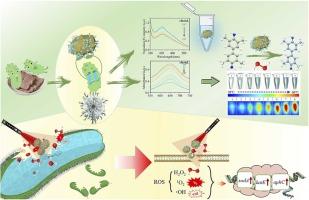“Dandelion” magnetic bead-driven CDs@CeO2 based-multifunctional nanoplatform for tri-modal ultrasensitive detection and efficient eradication of pathogenic bacteria
IF 8
1区 化学
Q1 CHEMISTRY, ANALYTICAL
引用次数: 0
Abstract
To address the challenge of foodborne pathogens, we have developed an ultra-sensitive tri-modal detection and effective pathogen eradication strategy utilizing a “dandelion” magnetic bead-driven cerium dioxide doped with carbon dots (CDs@CeO2) multifunctional nanoplatform. Aptamer (Apt) modification CDs@CeO2 specifically recognizes and binds to the outer membrane proteins of Salmonella typhimurium (S. typhimurium). Concurrently, mannose-functionalized dandelion-like magnetic beads selectively recognize adhesins of S. typhimurium, avoiding competition with Apt for binding sites and leveraging the strong bacterial capture capability for high-sensitivity detection. The prepared CDs@CeO2 has been demonstrated to exhibit favourable fluorescence characteristics. In the presence of H2O2, CDs@CeO2 is capable of oxidising colorless 3,3′,5,5′-tetramethylbenzidine (TMB) into blue oxide, displaying exceptional photothermal properties. CDs@CeO2 have the potential to generate •OH through a Fenton-like reaction, which could directly damage cells. Notably, coupling the photosensitizer Ce6 to CDs@CeO2 and subsequent illumination generates 1O2, which synergistically eradicates bacteria with •OH. Detection limits of the fluorescence, colorimetry, and photothermal methods were 3.85 cfu/mL, 9.44 cfu/mL, and 5.00 cfu/mL, respectively. The platform successfully achieves precise detection of S. typhimurium in actual pre-prepared food samples through fluorescence, colorimetry, and photothermal tri-modal signals, and effectively kills bacteria, achieving trace detection and source control.

基于 "蒲公英 "磁珠驱动的 CDs@CeO2 多功能纳米平台,用于三模式超灵敏检测和高效根除病原菌
为了应对食源性病原体的挑战,我们利用 "蒲公英 "磁珠驱动的掺杂碳点的二氧化铈(CDs@CeO2)多功能纳米平台,开发了一种超灵敏的三模式检测和有效的病原体根除策略。经 Aptamer(Apt)修饰的 CDs@CeO2 可特异性识别鼠伤寒沙门氏菌(S. typhimurium)的外膜蛋白并与之结合。同时,甘露糖功能化的蒲公英状磁珠可选择性地识别鼠伤寒沙门氏菌的粘附蛋白,避免与 Apt 争夺结合位点,并利用强大的细菌捕获能力进行高灵敏度检测。实验证明,制备的 CDs@CeO2 具有良好的荧光特性。在 H2O2 的存在下,CDs@CeO2 能够将无色的 3,3',5,5'-四甲基联苯胺(TMB)氧化成蓝色氧化物,显示出卓越的光热特性。CDs@CeO2 有可能通过类似芬顿的反应生成-OH,从而直接损伤细胞。值得注意的是,将光敏剂 Ce6 与 CDs@CeO2 相耦合,然后进行照射,会产生 1O2,从而与 -OH 协同消灭细菌。荧光法、比色法和光热法的检测限分别为 3.85 cfu/mL、9.44 cfu/mL 和 5.00 cfu/mL。该平台通过荧光、比色和光热三模信号成功实现了对实际预制食品样品中伤寒杆菌的精确检测,并有效杀灭细菌,实现了痕量检测和源头控制。
本文章由计算机程序翻译,如有差异,请以英文原文为准。
求助全文
约1分钟内获得全文
求助全文
来源期刊

Sensors and Actuators B: Chemical
工程技术-电化学
CiteScore
14.60
自引率
11.90%
发文量
1776
审稿时长
3.2 months
期刊介绍:
Sensors & Actuators, B: Chemical is an international journal focused on the research and development of chemical transducers. It covers chemical sensors and biosensors, chemical actuators, and analytical microsystems. The journal is interdisciplinary, aiming to publish original works showcasing substantial advancements beyond the current state of the art in these fields, with practical applicability to solving meaningful analytical problems. Review articles are accepted by invitation from an Editor of the journal.
 求助内容:
求助内容: 应助结果提醒方式:
应助结果提醒方式:


